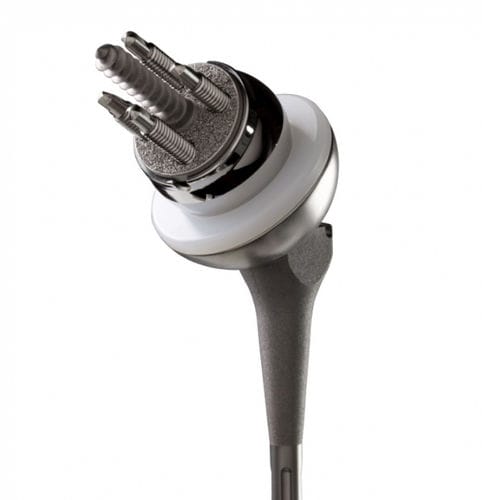
- Secondary care
- Orthopedic surgery
- Reverse shoulder prosthesis
- Enovis Surgical
Reverse shoulder prosthesis RSP®revisioncemented
Add to favorites
Compare this product
Characteristics
- Shoulder prosthesis type
- reverse
- Surgical application
- revision
- Fixation
- cemented
Description
The Reverse Shoulder Prosthesis (RSP®) was the first reverse shoulder design to successfully incorporate a center of rotation (COR) lateral to the glenoid.
The RSP system features an anatomic humeral neck-shaft angle. Biomechanical testing has shown that having a humeral neck-shaft angle in the range of normal anatomy reduces the potential for inferior scapular notching.
For successful bony ingrowth, a stable interface between the bone and the prosthetic device is required during initial healing. The design of the RSP baseplate provides 2000N of compression between the prosthesis-bone interface, providing stable initial fixation as well as ideal conditions for bony ingrowth for long-term fixation.
A great deal of variability can be experienced in rotator-cuff-deficient shoulders. The RSP system offers unmatched versatility, in size and offset, of glenospheres to manage complex anatomy and surgical outcomes.
The RSP is one of the most well-published reverse shoulders on the market with over forty peer reviewed journal publications.
FEATURES & BENEFITS:
Positioned approximately 12mm below the resected humeral neck osteotomy to ensure that the humeral socket is surrounded by proximal bone support for strength, stability and fixation.
Anatomical-shaped proximal body
Cylindrical-shaped distal segment with cement flutes
Cemented application only
Primary stem: 6 x 101mm, 7 x 105mm, 8 x 109mm, 10mm x 116mm, and 12mm x 124 mm
Revision sizes: 6mm, 8mm, 10mm, and 12mm in one length of 175mm
Catalogs
No catalogs are available for this product.
See all of Enovis Surgical‘s catalogsRelated Searches
- Bone plate
- Compression plate
- Metallic compression plate
- Locking compression plate
- Surgical support
- Agitator
- Proximal compression plate
- Benchtop stirrer
- Femoral stem
- Humeral compression plate
- Blender
- Knee prosthesis
- Acetabular prosthesis
- Cementless femoral stem
- Benchtop mixer
- Press-fit acetabular prosthesis
- Rotary blender
- Hip prosthesis
- Cemented femoral stem
- Fixed-bearing knee prosthesis
*Prices are pre-tax. They exclude delivery charges and customs duties and do not include additional charges for installation or activation options. Prices are indicative only and may vary by country, with changes to the cost of raw materials and exchange rates.


